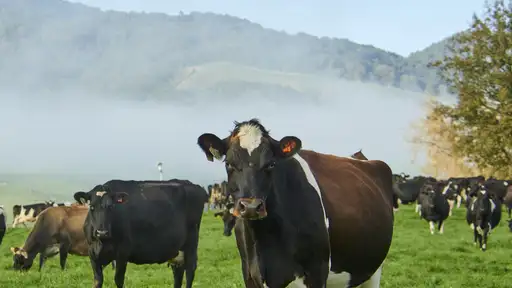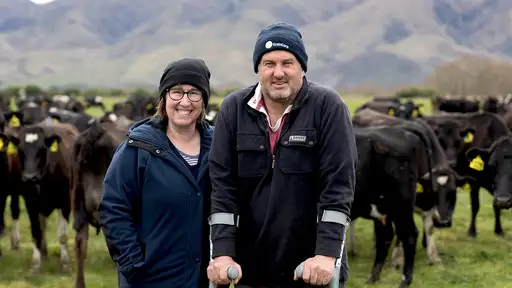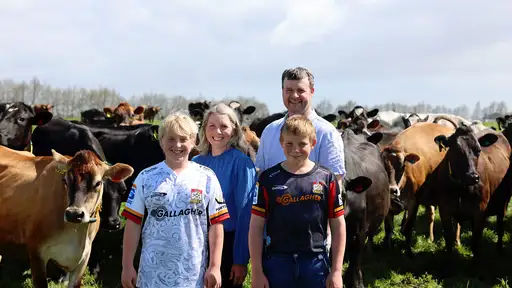At mating, the choice of bulls to sire the next generation of replacements is many and varied: Premier Sires vs Alpha? This bull, or that bull? A team of five bulls or 10 bulls?
All decisions require a level of trust in the quality of animal evaluation information that sits behind bull selections.
The engine room of LIC’s bull selections is the LIC genomic evaluation model, which had its most significant recent update implemented in February 2020.
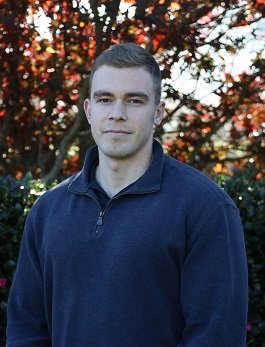
Since then, both the number and quality of genotypes used for genomic evaluation has significantly increased, leading to better estimations of genetic merit.
The use of genomics has enabled for widespread use of bulls at a young age, years before the bulls’ daughters have information of their own.
While this reduction in the sire generation interval has huge benefits for increasing rates of genetic gain, it’s important to not lose sight of the practical application of bull teams on-farm; more specifically, the reliability of gBW and the appropriate use of a team of young genomic bulls.
For all traits, reliability is measured on scale of 0 to 100%, and indicates the confidence that an animal’s gBW (or individual breeding values) are a measure of their true merit. The breeding value for each trait has an associated reliability and will change over time with the addition of more information from sources like ancestry and daughter information.
The gBW index is a combination of breeding values and economic values for 10 traits that have measurable economic value to New Zealand dairy farmers. Changes to gBW are not limited to the addition of new information; factors such as economic value updates and model changes also influence gBW changes.
Ultimately, changes to gBW provide a more accurate ranking of bulls on their expected ability to breed profitable and efficient replacements, while reliability of gBW serves as a useful indication of the amount of information behind the estimate.
Without a genotype, a young bull will have a gBW that represents his parent average genetic merit and will carry a gBW reliability of 30-40%. At this early age it is not known whether the bull received a ‘favourable’ or ‘unfavourable’ combination of genes from sire and dam.
Cue the value proposition of genomics.
Take the same bull and add the information from his own genotype and the gBW reliability will increase to around 50-60%.
At this level of reliability, movement in gBW is still expected once daughter information is obtained for a young genomically-evaluated bull. However, the accuracy of this early genomic prediction provides a far greater estimate of lifetime genetic merit over and above what can be obtained through parent average information alone.
What does this mean for bull selections?
Putting all your eggs in one basket by choosing only a couple of young genomic bulls, opens the door for differences in team gBW expected vs team gBW delivered. But this should not deter farmers from selecting young genomic bulls, as early access to these genetics is an opportunity to get ahead of the pack.
Picking an adequate number of bulls means that the team gBW delivered will match the team gBW expected, smoothing out any upward or downward movements in gBW at an individual bull level.
Finding the sweet spot between gBW gain and target number of bulls will ensure that the risk versus reward is balanced appropriately, while maintaining genetic diversity across the herd.
Table 1 provides estimates of team gBW reliability under increasing numbers of young genomic bulls. The ‘sweet spot’ is around 6-10 young genomic bulls which will balance team gBW with team gBW reliability. Selecting more bulls will further increase the team gBW reliability, however may compromise genetic gain through having to select additional bulls.
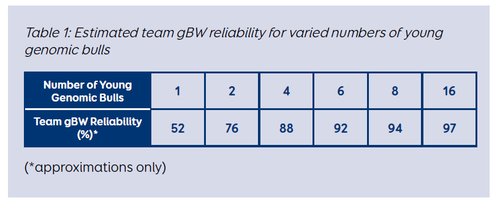
The team approach is a non- negotiable principle to a balanced breeding approach which should always be considered at the time of making bull selections.
Getting the balance right will manage the potential variation at an individual level, while breeding the best cows for your herd of the future.
